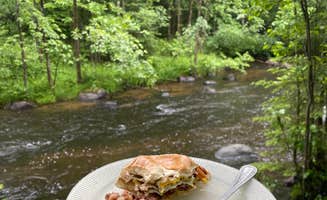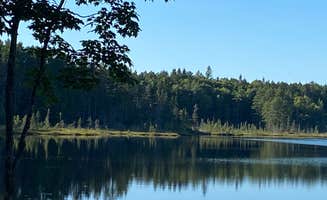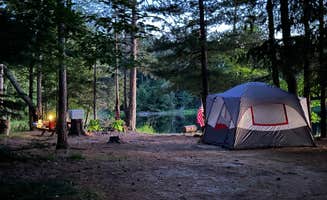Dispersed camping options near Armstrong Creek, Wisconsin are found throughout the Chequamegon-Nicolet National Forest, which spans over 1.5 million acres of northern Wisconsin. The forest terrain features a mix of glacially-formed rolling hills with elevations ranging from 800 to 1,600 feet. Winter temperatures typically drop below 0°F, while summer camping season brings highs in the 70-80°F range with frequent afternoon thunderstorms.
What to do
Fishing opportunities: Several small lakes provide quiet angling experiences with minimal competition. At McKinley Lake Dispersed, visitors can access "a single campsite" that's ideal for fishing enthusiasts with "access to lake" directly from the campsite.
Wildlife observation: Loon watching is exceptional at Wolf Lake Campsite where campers report the "small lake belongs to a pair of loons that will share their fish and sandy beach." Many visitors bring binoculars for birdwatching as the area hosts numerous migratory species.
Hiking nearby trails: Several primitive campsites provide access to adjacent trail networks. According to a visitor at Indian Lake, the "campsite is just off a paved road making it easily accessible" with "many hiking opportunities" in the immediate vicinity.
Paddling small lakes: The region's isolated water bodies are perfect for kayaks and canoes. Woodbury Lake Campsite features "a sandy beach great for swimming or paddling" according to recent visitors, with no motorized restrictions.
What campers like
Secluded waterfront sites: Many campers appreciate the private access to water features. At Wolf Lake Campsite, one visitor notes "I love this campsite. The small lake belongs to a pair of loons that will share their fish and sandy beach."
Affordable camping options: Most sites require minimal fees or none at all. At Octonto River - South Branch, campers enjoy "Peace for $5" with two well-spaced campsites and "a clean and maintained vault toilet" for those wanting basic amenities at low cost.
Natural swimming areas: Several locations offer swimming access directly from campsites. Woodbury Lake Campsite visitors mention the "remote site has a sandy beach great for swimming or paddling" with adequate space for camping equipment.
Solitude from crowds: Most dispersed sites provide peaceful camping experiences. Three Johns Lake Dispersed has just "one [site] on lake" providing campers with exceptional privacy in a tent-only setting.
What you should know
Access road conditions: Forest road quality varies considerably by season. Bose Lake Campsite access "is narrow and pot holed" according to a recent visitor, requiring careful navigation even for smaller vehicles.
Limited connectivity: Cell service ranges from nonexistent to minimal across most sites. At Oconto River off Mountain Lake Road, visitors report "No Service" making these locations unsuitable for those needing regular connectivity.
Vehicle requirements: Some locations require appropriate clearance. Oconto River access challenges include reports that "4x4 recommended. 2wd truck couldn't make it easily" and warnings to "not follow road past campsites, either way unless your vehicle is lifted."
Toilet facilities: Maintenance of primitive facilities varies by location and season. McCaslin Brook Dispersed sites have "wilderness toilet" facilities, while most lake campsites like Harriet Lake offer only basic fire rings and picnic tables.
Tips for camping with families
Site selection for children: Choose locations with gradual water entry for safer swimming. Harriet Lake Campsite offers a "small lake has fire ring and picknick table" that's classified as a "no motor lake" making it quieter and safer for families with young children.
Avoid busy weekends: Holiday periods bring increased traffic on forest roads. Many campers recommend mid-week visits during summer for better site availability and reduced ATV traffic in areas like Mountain Lakes Road.
Pack entertainment: Limited activities at primitive sites require bringing family games. Three Johns Lake's "tents only" designation with a "short walk to campsite" makes it suitable for families comfortable with minimal amenities and who bring their own recreation equipment.
Safety preparations: Bring comprehensive first aid supplies as medical facilities are distant. Most sites are 30+ minutes from emergency services with limited cell coverage, requiring appropriate preparation for potential injuries or emergencies.
Tips from RVers
Size restrictions: Most dispersed sites accommodate only smaller RVs. At McCaslin Brook Dispersed site, a camper notes there are "three sites two small one large site which you can fit larger camper or RV in" but cautions the "middle camp site has best access to brook I put a 8 foot pop up in it you could go bigger 20 foot max."
Solar considerations: Dense forest canopy limits solar charging options. One visitor observed that McCaslin Brook was "so shaded. While that made it nice and cool, it made solar & Starlink impossible."
Leveling challenges: Bring adequate leveling equipment for uneven parking areas. Wolf Lake Campsite can "fit a 20 footer easy" according to visitors, but like most forest sites, parking pads aren't necessarily level or uniformly compacted.
Water access planning: No potable water exists at these sites, requiring self-sufficiency. Most RVers recommend bringing 1-2 gallons per person per day plus additional water for cleaning and other needs while staying at these rustic camping locations near Armstrong Creek.




